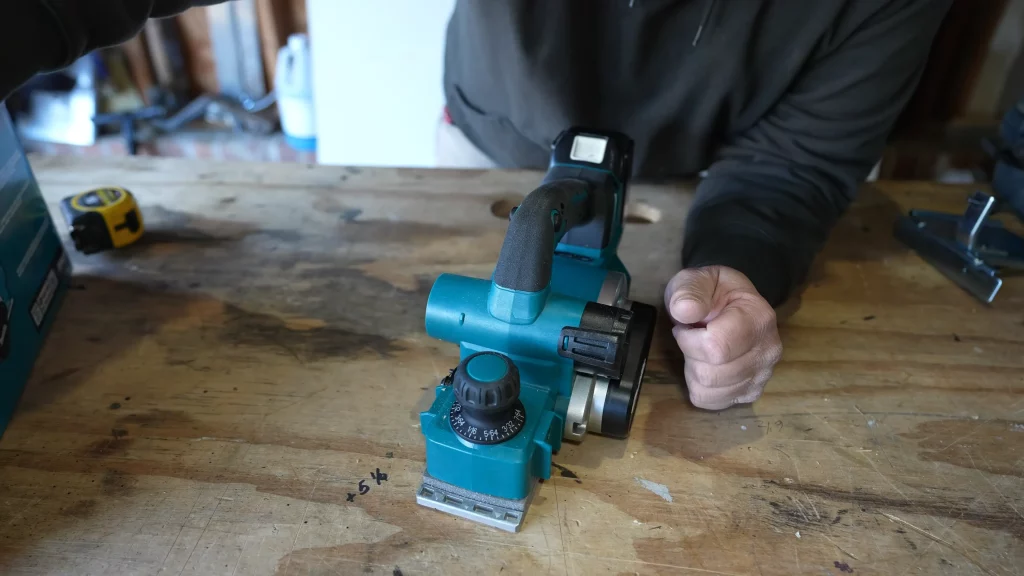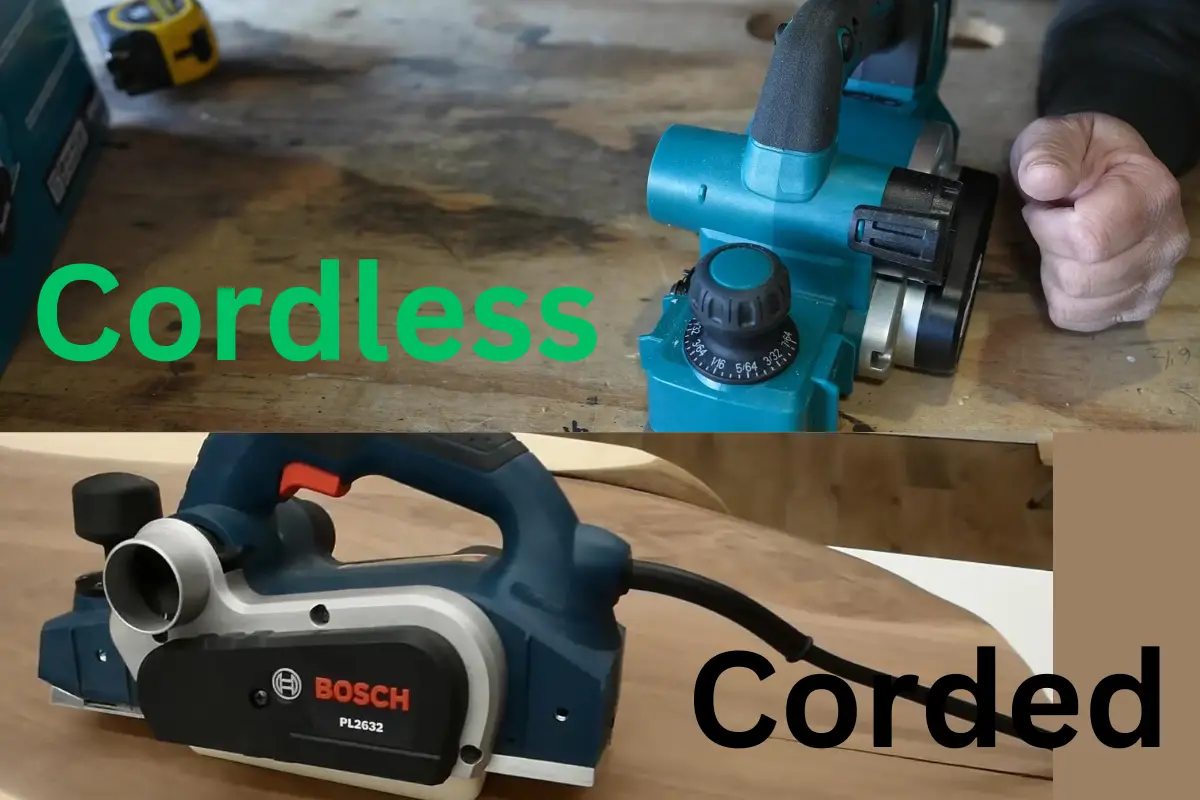Corded vs Cordless Planer [7 Key Differences]
Planers come in two main types – corded electric planers that need to be plugged into a power outlet, and cordless portable planers that run on rechargeable batteries.
Both corded and cordless planers have their own set of pros and cons.
The choice between them depends on factors like portability needs, power requirements, planing workload, and budget.
In this comprehensive guide, we’ll examine the key differences, pros and cons, uses, and other factors to consider when choosing between corded and cordless wood planers.
Corded vs Cordless Planer Comparison Table
| Feature | Corded Planer | Cordless Planer |
|---|---|---|
| Power Source | Electrical outlet | Rechargeable battery packs |
| Runtime | Unlimited when plugged in | Limited per charge |
| Power | High, 15+ amp motors common | Lower than corded, less material removal |
| Portability | Limited by cord length | Fully portable |
| Noise Level | Louder | Quieter operation |
| Cost | Lower initial cost | Batteries raise cost |
| Planning Width | Up to 12″ | Typically under 9″ |


Key Differences Between Corded and Cordless Planers
Here are the main differences between corded and cordless wood planers:
Portability
- Cordless planers are completely portable since they don’t need to be plugged into a wall outlet. You can take them anywhere and use them on job sites away from power sources.
- Corded planers have limited portability as they can only be used within reach of a wall power outlet. An extension cord increases their range but reduces power.
Power and Performance
- Corded planers are more powerful and can handle tougher planing tasks on hardwoods. They have higher amperage motors (10-15 amps) that deliver consistent power.
- Cordless planers have less power due to battery limitations. They work well for lighterduty planing of softwoods and thin stock removal. Typical amperage is 6-10 amps.
Run Time
- Cordless planers run for 30-60 minutes on a fully charged battery depending on workload. Batteries need 1-2 hours to recharge.
- Corded planers offer continuous, uninterrupted run time as long as they’re plugged in. No downtime for recharging batteries.
Planing Capacity
- Corded planers generally have higher planing width and depth capacity – they can plane wider (15″) and thicker (1/2″ cuts) stock.
- Cordless planers typically max out at 12″ planing width and 1/4″ cut depth due to battery power limitations.
Cost
- Cordless planers are more expensive since the cost of batteries and chargers is added. Prices range from $200 to $400.
- Corded planers start at around $150 and go up to $350 for heavy-duty models. No battery costs.
Pros of Corded Electric Planers
Higher Power and Performance
With 10-15 amp electric motors, corded planers have 50-100% more power than cordless planers. They can plane thicker stock removal and handle tougher woods like maple and hickory with ease. The consistent wall power enables them to maintain top performance.
Larger Planing Width and Depth
Commercial corded planers can plane up to 20″ wide stock and make cuts up to 1/2″ deep in a single pass. This allows faster planning of wider and thicker lumber.
Continuous Run Time
Since corded planers plug directly into wall outlets, they offer unlimited runtime as long as electricity is available. You don’t have to stop in the middle of a project to recharge batteries.
Lower Cost
Without expensive lithium-ion batteries and chargers, corded planers are cheaper to buy. Heavy-duty 15 amp corded planers cost less than $400 while similar cordless planers cost over $500.
Don’t Have to Replace Batteries
Cordless tool batteries deteriorate over time and need replacement after a few years. You avoid this added cost with a corded planer that doesn’t rely on batteries.
Cons of Corded Electric Planers
Lack of Portability
The power cord seriously limits where you can use a corded planer. You always need to be within reach of a wall outlet which is problematic at remote job sites. Extension cords affect performance.
Not for Outdoor Use
It’s hazardous to use corded power tools outdoors when it’s raining or wet conditions. The risk of electrocution and short circuits means corded planers are best limited to indoor shop use.
Cord Hazard
The planer’s power cord can get in the way and is a tripping hazard, especially in a busy shop environment. Unexpected cord disconnects will abruptly stop the planer.
Limited Use with Generators
While corded planers can theoretically run off a generator, most affordable generators lack sufficient output to power them. Voltage fluctuations can damage the planer.
Can’t Plane Small or Narrow Stock
Benchtop thickness planers are unsuitable for planing small workpieces under 12″ long or narrower than 3″. Minimum workpiece size is limited.
Pros of Cordless Planers
Fully Portable
The key benefit of cordless planers is the ability to use them anywhere. Their portability lets you plane lumber at job sites, outdoors, or wherever needed without requiring wall power.
Safer for Outdoor Use
Lacking a corded connection, cordless planers are much safer for smoothing lumber outside. There’s no risk of electric shocks, short circuits or cord hazards.
No Cord Limitations
A cordless planer has no power cord to constantly manage, preventing tangled cords or unexpected disconnections while planing. You have unlimited mobility.
Quieter Operation
Without the loud universal motor of a corded planer, cordless models operate quieter at around 85-90 dB. This reduces noise pollution in your workshop or job site.
Lower Amp Draw
Cordless planers pull less amperage (6-10 amps) so can be powered from lower capacity generators or solar panel setups when electricity isn’t available.
Cons of Cordless Planers
Less Powerful
Limited by battery output, cordless planers max out at 6-10 amps while corded planers can do 10-15 amps. This impacts planing capacity and performance, especially on hardwoods.
Weaker Motors
Battery-powered motors in cordless planers tend to be lower quality and wear out faster compared to heavy-duty universal motors in corded models. Their power can fade over time.
Smaller Capacity Cuts
The low power of cordless planers allows planing cuts of just 1/8″ to 1/4″ depth per pass. Corded planers can handle up to 1/2″ cuts for faster stock removal.
Short Run Times
Even large 10Ah batteries only provide 30-60 minutes of cordless planer run time before needing 1-2 hours to recharge. Planing operations get interrupted.
Costlier Upfront
Including lithium-ion batteries and chargers makes cordless planers about 25% more expensive than comparable corded models. Batteries also require periodic replacement.
Main Uses for Corded and Cordless Planers
Here are the ideal uses for each type of electric planer based on their capabilities:
Corded Planer Uses
- Smoothing thick hardwood stock
- Heavy-duty planing of wide boards
- Long planing sessions of 100+ boards
- Flattening rough lumber up to 20″ wide
- Cabinet shops, mills, and pro woodworking shops
Cordless Planer Uses
- Quick touch-ups and light planing
- Portable surface planing at job sites
- Outdoor planing tasks
- Planing thin boards under 6″ width
- DIYers and hobbyist woodworkers
Features to Look for When Buying
Here are key features to consider when choosing between cordless and corded planers:
- Power – Amp rating, motor quality
- Planing width – Maximum cutterhead width
- Cutting depth – Maximum cut per pass
- Cutterhead speed – Cuts per minute
- Table extensions – For planing long boards
- Dust collection – Built-in blower and port
- Battery – For cordless, battery Ah, run time
- Price – Factor in batteries for cordless
Top Planer Models
Best Corded Planers
- WEN 6530
- PORTER-CABLE PC60THP
- Bosch PL1632
- DEWALT DW680K
- Craftsman CMEW300
Best Cordless Planers
In A Nutshell
Corded and cordless power planers each have their strengths and tradeoffs. Corded models provide the highest power for fast heavy cuts but lack mobility. Cordless planers allow complete portability for ease of use but have limited capacity.
Understand your needs in terms of power, board width, runtime, and mobility. For light use on narrow boards, cordless works well. For heavy smoothing of wide boards, choose a powerful corded model. With their different strengths, having both kinds of planers is ideal to cover all planning needs.
FAQs
Can you use a cordless planer for long periods?
Cordless planers have limited runtime per battery charge, usually 15-60 minutes depending on workload. They are best for shorter intermittent planning tasks, not continuous long-term use. Take breaks to let batteries recharge. Have multiple charged battery packs on hand for extended use.
What battery voltage is best for cordless planers?
Higher voltage means more power. Look for 18V, 20V, or higher batteries. Lower voltage planers under 10V are too underpowered. Many tools now use interchangeable battery packs in the 18-20V range.
What size planer is best for fine woodworking?
For detailed fine woodworking, a light-duty benchtop planer in the 12-15 amp range is ideal. Prioritize smoothness over power. Portable handheld planers around 10 amps also work well. Avoid heavy 20 amp models designed for high material removal.
Can you sharpen planer blades?
Yes, planer blades can be sharpened to extend their lifespan. Check the blade frequently. When performance drops or snipe occurs, it’s time to sharpen. Use a diamond sharpening stone. Reset the blades to the same height after sharpening. Replace extremely worn blades.
Can you use a planer to make boards thinner?
Yes, a planer is an efficient way to resize the thickness of boards. Remove material in light passes taking off 1/16″ or less per pass. Be careful not to exceed the planer’s capacity – remove too much material in one pass and you risk damage.
Can hand planes replace a power planer?
For skilled woodworkers, hand planes can often replace a power planer. It just requires more physical effort and time. Hand planes give ultimate control over the cutting process. But power planers are better for batch processing large amounts of lumber efficiently.
I hope this comprehensive overview helps explain the key similarities, differences, pros and cons, and ideal uses for corded and cordless power planers.


